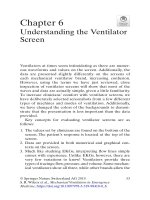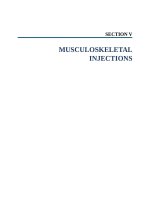Ebook On rounds - 1000 internal medicine pearls: Part 2
Bạn đang xem bản rút gọn của tài liệu. Xem và tải ngay bản đầy đủ của tài liệu tại đây (2.91 MB, 114 trang )
8
Fever,TemperatureRegulation,and
Thermogenesis
CHAPTER
CENTRALREGULATIONOFCORETEMPERATURE
FEVERANDHYPERTHERMIA
THERMOGENESIS
HEATGENERATIONANDDISSIPATION
DIURNALVARIATIONINTEMPERATURE
NIGHTSWEATS
CENTRALREGULATIONOFCORETEMPERATURE
Temperatureinhumansiscontrolledbythehypothalamusaroundasetpointof
about37°C(98.6°F),byacomplexseriesofmechanismsthatpermitthe
generation,conservation,anddissipationofheat.
Homeothermy requires a balance of heat generation, heat conservation, and heat
dissipation.Thisisaccomplishedbyaremarkableseriesofcoordinatedcardiovascularand
metabolicresponsesintegratedinthehypothalamus,andfinetunedintheeffectororgans
peripherally. These responses involve the autonomic nervous system, the skeletal
musculature,arteriesandveins,thesweatglands,andbrownadiposetissue(BAT).
FEVERANDHYPERTHERMIA
Fever represents a resetting of the temperature set point up; antipyretics adjust the set
pointdownwhenthelatteriselevatedbyfever.
Feverisdistinctfromhyperthermia.
In hyperthermia the core temperature rises because heat dissipation mechanisms are
impaired,orbecauseheatproductionexceedsthecapacityofheatdissipationmechanisms,
notbecauseofanincreaseincentraltemperaturesetpoint.
Infectionscausefeverviacytokinereleasefrominflammatorycells.
Infact,thefirstcytokinedescribedwascalled“endogenouspyrogen”sinceitwasreleased
from host leukocytes after exposure to bacteria. It had previously been thought that
bacterial products per se caused the fever. Cytokines released from tumor cells also cause
thefeverthatisassociatedwithmalignancy.
THERMOGENESIS
Thermogenesis,literallyheatproduction,isnotsynonymouswithfever.
In warm-blooded mammals (homeotherms) basal heat production (or basal metabolic rate
[BMR])istheheatproducedatrestbymitochondriathroughoutthebody.BMRisregulated
bythyroidhormones.
Excessivesweatingistheclinicalmanifestationofincreasedheatproduction
withoutariseintemperature.
In hyperthyroidism BMR is increased (thermogenesis), but fever is absent unless the
increasedheatproductionoverwhelmstheheatdissipationmechanisms.
HEATGENERATIONANDDISSIPATION
Heatdissipationmechanismsincludesweatingandvasodilation.
Vasodilation results in the loss of heat through the skin by radiation; sweating cools via
evaporativeheatloss.Thelatterisregulatedbycholinergicsympatheticnervestothesweat
glands.
Ariseintemperatureof1°Cresultsina10%to13%increaseinmetabolicrate,
contributingtotheweightlossnotedduringprolongedfebrileillness.
Maintenance of normal body temperature in spite of differing ambient conditions
(homeothermy, the “warm blooded” state) consumes a significant amount of total energy
production(about50%innormallyactiveman).
Rigorsreflecttherapidityofariseintemperature;theyarenotspecificforany
particularcauseofthefever.
Heat generation occurs by the muscular activity induced by shivering; as the temperature
risesduringfebrileillnessepisodesofshiveringareexperiencedasrigors.Itisafauxpearl
thatrigorsarecausedprincipallybygram-negativebacterialinfections.
BATisaheat-generatingorgan.
Although the role for BAT in physiologic heat production in small mammals and human
neonates has been well accepted, BAT was long dismissed as irrelevant in adult humans.
BAThasnowbeenresuscitatedandisgenerallyrecognizedasfunctionalinmanyadults.It
isafauxpearlthatBATisneitherpresentnorfunctionalinolderhumans.Apotential
roleforBAT(orlackthereof)inthepathogenesisofobesityisunderinvestigation.
The production of metabolic heat in BAT is regulated by the sympathetic nervous system
which turns on BAT metabolism by a β-3 receptor-mediated process. In the presence of
uncouplingprotein(UCP),BATmitochondriabecomeuncoupledsothatsubstrateoxidation
results in the production of heat rather than the synthesis of ATP. The location of BAT
around the great vessels in the thorax facilitates distribution of the generated heat
throughout the body. Heat production in BAT is markedly enhanced by chronic cold
exposure,aprocessknownascoldacclimation;inthecoldacclimatedstatemetabolicheat
replacestheneedtoshiverduringcoldexposure.
Inhumanstheextremitiesplayanimportantroleintemperatureregulation.
Heat conservation occurs via vasoconstriction of arteries and superficial veins in the
extremities. Venoconstriction, particularly in the superficial veins of the extremities, is
mediatedbyα-2adrenergicreceptors,whilethedeepveins,whichformaplexusaroundthe
arteriesintheextremities,aremoreheavilyendowedwithα-1receptors.Externalcooling
decreases α-1 receptor affinity for NE in deep veins but increases α-2 affinity in the
superficialveins,favoringashiftofbloodtothedeepvenoussystem.Thedeepveinsforma
plexusaroundthearteriesthatsupplytheextremities,thusprovidingtheanatomicbasisfor
acountercurrentheatexchangemechanism.Thesevascularchangesefficientlyreturnheat
fromthearterialsystemperfusingtheextremitiestothecentralvascularcompartment.The
opposite vascular changes potentiate heat dissipation in a warm environment or when
exercisenecessitatesheatloss.
Whenprescribingantipyreticsitispreferabletodosethedrugsataregular
intervalratherthanPRNforariseintemperature,inordertoavoidrepeated
heatgenerationanddiaphoresisastheantipyreticwearsoffandis
readministered.
During a febrile response heat is both conserved and generated, thereby raising the core
temperature. Paradoxically, the patient feels cold since the core temperature is below the
new(febrile)setpoint.Whenthefeverbreaks,eitherthroughresolutionoftheinfectionor
the administration of antipyretics, heat is dissipated by vasodilation and sweating; the
patient, paradoxically, feels warm, the core temperature now being above the normal set
point.
DIURNALVARIATIONINTEMPERATURE
Typically,feverpeaksintheeveninganddiminishesinthemorning,constituting
asingledailyspike.
Somediseases,however,arecharacterizedbyunusualfeverpatterns.
InAdultStill’sdisease(juvenilerheumatoidarthritis[JRA])twodailyspikesare
common.
JRAisanimportantcauseofundiagnosedfebrileillnessinadults.Itisadifficultdiagnosis
toestablishsincethemanifestationsarenonspecific(arthralgias,fever,sorethroat)andthe
characteristicrashisfrustratinglyevanescent.Inflammatorymarkersaretypicallyveryhigh
(WBC,plateletcount,ferritinlevel).
Inmalariatheclassicalpatternofeveryotherdayoreverythirddayfeverspikeis
notestablishedearlyinthedisease,sodailyspikesaretheruleatthetimeof
presentation.
Patientsreturningfromanindigenousareawithhighspikingfever,headache,andmalaise
should be suspected of having malaria, especially if they have not taken appropriate
prophylaxis.
Inpatientswithaprolongedfebrileillnessthatdefiesdiagnosisthecauseis
usuallymalignancy.
Hospitalized patients with undiagnosed fever despite repeated cultures and imaging will
usuallybefoundtohaveanoccultmalignancyratherthananoccultinfection.
NIGHTSWEATS
Whydofebrile(andnonfebrile)patientssweatatnight?
Duringsleepthecoretemperaturefallsalmost0.5°C;tomeettheloweredcentral
setpoint,heatdissipationmechanismsareactivatedresultinginsweatingand
vasodilation.
Although the temperature is falling paradoxically the patient feels hot (since the actual
temperatureisabovetheloweredsetpoint).
9
InfectiousDiseases
CHAPTER
FEVEROFUNKNOWNORIGIN
INFECTIONSOFSPECIFICSITES
UrinaryTractandKidney
Liver
SpineandEpiduralSpace
Pharyngitis
LungAbscess
BowelInfections
ViralGastroenteritis
BACTERIALGASTROENTERITIS
Salmonella
Campylobacter
Shigella
PathogenicEscherichiaColi
ClostridiumDifficile(C.diff)
StaphylococcalEnterotoxinEnteritis
SPECIFICINFECTIOUSAGENTS
Gonococci(GC)
Meningococci
StaphylococcalInfections
Syphilis(Lues)
HerpesZoster
HerpesSimplexVirus(HSV)
GLOBALIZATIONANDINFECTIOUSDISEASE
Malaria
DiseasesthathaveSpreadBeyondtheirTraditionalLocales
T
heclinicalproblempositedmostofteninafebrilepatient:Isaninfectionpresent?Ifso,
where is the likely site and what is the likely organism? If not infectious, what is the
cause?
FEVEROFUNKNOWNORIGIN
Prolongedfevers(greaterthan101°Ffor2to3weeks)thatdefydiagnosisutilizingstateof
the art testing are much less common now than in past decades, largely because of better
imaging modalities and improved microbiologic techniques that better identify occult
infections. Interestingly, however, the fundamental causes have remained amazingly
similar: infections (including tuberculosis [TB]); malignancies (predominantly,
lymphoproliferativediseases);andcollagenvascular(autoimmunediseases).
Whenanexhaustivesearchforinfectionisnegativeoccultmalignancyisthe
usualcauseofprolongedunidentifiedfevers.
It should be pointed out, however, that some patients recover completely with no cause
identified and others recur and still defy diagnosis. Extrapulmonary TB needs to be
consideredinpatientswithprolongedfeversthatdefyidentification.
INFECTIONSOFSPECIFICSITES
UrinaryTractandKidney
Lowerurinarytractinfections(cystitis)areassociatedwithfrequencyand
dysuria,butnotfever;feverindicatespyelonephritis.
Acute pyelonephritis may take 72 hours to respond to antibiotics, but in general is not a
seriousdiseaseparticularlyinyoungwomen.Theusualorganismsaregastrointestinal(GI)
bacteriacommonlyEscherichiacoli,orKlebsiella.
Repeatedattacksofpyelonephritisrequireevaluationforstructuralurinarytract
abnormalities.
Inmenpyelonephritissuggestsobstruction,usually,prostatichypertrophy.
ApositiveurinecultureforStaphylococcusaureussignifiesstaphylococcal
bacteremiaandhasthesamesignificanceasapositivebloodculture.
Althoughstaphmaysecondarilyinfectthekidneys,apositiveurinecultureforshouldnotbe
ascribedtoprimarykidneyinfection.
SterilepyuriaraisesthequestionofgenitourinaryTB.
The renal collecting system is not an uncommon site of extrapulmonary TB. Hematuria is
alsocommoningenitourinaryTB,andcalcificationsmaybenotedinthecollectingsystem
onx-ray.
Liver
Hepaticabscessesareoftwoprincipaltypes:pyogenicandamoebic;pleuritisor
invasionoftherightlowerthoracicpleuralspacestronglysuggestsanamoebic
etiology.
Traditionally difficult to diagnose and an important cause of undiagnosed febrile illness,
advanced imaging techniques have made recognition of liver abscess relatively easy,
althoughearlyinthecourseofdiseasethesetechniquesmaynotbediagnostic.Elevationof
therighthemidiaphragmonchestx-raymaysuggestthediagnosis.
Pyogenicabscessesareusuallyaconsequenceofasepticfocusintheabdomenor
thebiliarysystem.Anaerobicorganismsarefrequentlyinvolved.
Amoebicabscessisaconsequenceofcolonicinfection,principallyinthececum,
andmayfollowaboutofamoebichepatitis.
Portal drainage of the cecum preferentially delivers blood to the posterior aspect of the
right lobe explaining the predominant location of amoebic abscesses in the right lobe
posteriorly. Secondary infection of amoebic abscesses with pyogenic anaerobic bacteria is
not unusual. Prompt catheter drainage is required in addition to appropriate antibiotic
treatment.
Ascendingcholangitis,asuppurativecomplicationofbiliarytractobstruction,is
associatedwithrapidlyprogressivejaundice.
Biliary stones in the common bile duct are the most common cause, but strictures and
carcinomas (ampullary, pancreatic, and cholangiocarcinoma) may be complicated by
cholangitis as well. Cholangitis is said to be “ascending” because the biliary tract, usually
sterile, is infected by invading organisms from the gut in the presence of obstruction. The
responsible organisms are usually gut flora, aerobic gram-negative rods, especially E. coli
and Klebsiella. The constellation of right upper quadrant pain, fever, and jaundice
(Charcot’s triad) suggests the diagnosis, but the key is rapidly progressive jaundice.
Anaerobicorganisms,usualinhepaticabscesses,arenotcommoninbiliaryinfections.
Acuteviralhepatitisisassociatedwithmalaise,anorexia,nausea,low-grade
fever,ictericskinandeyes,darkurine,andrightupperquadranttenderness.The
WBCisneverelevated(usually7,000)andthedifferentialreveals50%polysand
50%mononuclearcells.
Insmokersalossoftasteforcigarettesmaybeanearlysymptom.
HepatitisAvirus(HAV)occursinpointsourceepidemicsinvolvingfecalcontaminationof
waterorshellfishandmay(rarely)causesevereinjurywithhepaticfailurerequiringaliver
transplant;itisanotacauseofchronicliverdisease.HepatitisBvirus(HBV)andhepatitis
C virus (HCV) are blood-borne infections usually acquired from contaminated blood
productsorneedlesorthroughsexualcontact.HBVandHCVmayresultinchronicinfection
and cirrhosis as well as hepatocellular carcinoma. Collapse of the normal hepatic portal
architecturewithnecrosisthatbridgestheportaltriadspredictsthesubsequentdevelopment
ofcirrhosis.
TheimmunologicresponsetoHBVandespeciallyHCVmayresultinmixed
essentialcryoglobulinemia.
VaccinationhassignificantlyreducedtheincidenceofHAVandHBV.
Epstein–Barrvirus(EBV)andcytomegalovirus(CMV)mayalsocausehepatitis.
These infections characteristically cause a mild hepatitis, although CMV infections may be
prolongedeveninimmunocompetentpatients.
SpineandEpiduralSpace
Backpainandfeverstronglysuggestthediagnosisofspinalepiduralabscess.
Anepiduralcollectionofpusthatthreatensspinalcordcompression,spinalepiduralabscess
shouldberuledoutineverycaseofbackpainthatpresentswithfever.MRIisthepreferred
imagingmodality.
S.aureusistheinfectingorganismintwo-thirdstothree-fourthsofcaseswith
spinalepiduralabscess.
Hematogenous dissemination is the usual method of infection, although spread from
contiguous infection in a vertebrae or disc also occurs. Skin or soft tissue infection is
thoughttobetheusualportalofentry,althoughinasignificantportionofcasesnositecan
beidentified.
Otherorganismsresponsibleforepiduralabscessincludestreptococci,particularly
groupBstrep,gram-negativerods,nocardia,fungi,andmycobacteriumTB.
Lumbar puncture is contraindicated because of the possibility of spread of the infecting
organism. The thoracolumbar spine is the most common area involved. Elderly men are
mostcommonlyaffectedanddiabetesincreasesthesusceptibility.Tendernesstopalpation
isusually,butnotalways,present.
Signsofcordcompression(legweakness,incontinence,andasensorylevel)
indicatetheneedforimmediatedecompressionoftheepiduralabscessby
laminectomyanddebridement.
TheadministrationofantibioticsshouldbeginassoonasthediagnosisisestablishedbyMRI
andoperativeinterventionisneededatthefirstsignofcordcompression.
Vertebralosteomyelitisanddiscitispresentwithfeverandbackpain.
Thepathogenesisofvertebralanddiscinfectionissimilartospinalepiduralabscess,andS.
aureus is the common infecting bacteria. Unlike epidural abscess antibiotics are sufficient
for treatment and surgical debridement is not required unless the imaging or clinical
findingssuggestcordcompression.
Tuberculousinvolvementofthespinefrequentlyinvolvesadjacentvertebraeand
theinterveningdiscspace.
Apsoasabscessmaycomplicatetuberculousorpyogenicinfectionofthespineor
epiduralspace.Apositive“psoassign”maybeusefuldiagnostically.
Extensionofthehipwiththelegstraight,inthelateralpositionwiththeinvolvedsideup,
testsforapsoassign;thelatterispositivewhenpainiselicitedasthelegisextendedatthe
hip.Itisalsousefulindetectingretrocecalappendicitisastheinflamedappendixabutsthe
psoasmuscle.
Pharyngitis
GroupAstreptococciandEBV(infectiousmononucleosis)bothcauseacute
pharyngitis,tendercervicallymphadenopathy,andfever;theymaybedifficultto
distinguishonthebasisofphysicalexamination,butcaneasilybedifferentiated
byassociatedclinicalandlaboratoryfeatures.Bothinfectionsmayoccasionally
coexist.
Both strep and mono may have extensive exudate, tonsillar enlargement, and very
erythematouspharyngealmucosa.Monofrequentlyhaspalatalpetechiaeandanedematous
uvula.
Vomitingiscommonwithstrepthroat.Splenomegalyiscommonwithmono.
CBCwithdifferentialeasilydistinguishesthetwo:strepthroathasaleukocytosis
withgranulocytepredominance;monohasnormalorelevatedWBCwithmany
mononuclearcellsincluding(frequently)atypicallymphocytes(Downeycells)
whicharecytotoxicTcellsdirectedagainstinfectedBlymphocytes.
The “monospot” test, successor to the Paul–Bunnell heterophile agglutinin test, is quite
specific for mono, but lacks sensitivity especially early in the course of the disease and is
negativeinthemonth-longincubationperiod.Itmustbekeptinmindthatstrepandmono
may coexist, so a low threshold for a strep screen in patients with mono is a reasonable
idea.
Ifampicillin(oramoxicillin)isgiventoapatientwithmonoitisalmostcertain
thatarashwilldevelop;sucharash,however,doesnotnecessarilyindicatedrug
allergy.
ThehepatitisassociatedwithEBVinimmunocompetentpatientsis
characteristicallymildandnotassociatedwithchronicliverdisease.
LungAbscess
Thereareseveraldifferenttypesoflungabscess;thecommonfeatureisnecrosis
ofpulmonaryparenchymacausedbymicrobialinfection.
Themajorcausesofpulmonaryinfectionwithnecrosisare:1)aspirationoforopharyngeal
(particularly dental) flora; 2) suppuration and necrosis in an area of acute bacterial
pneumonia; 3) secondary infection in a necrotic area of lung as a complication of
bronchogenic carcinoma, collagen vascular disease (particularly Wegener’s
granulomatosis), or pulmonary embolus with infarction; and 4) metastatic infection from
hematogenousdisseminationofaninfectiousprocessinanotherregionofthebody.
Theclassiclungabscessisinanindolentanaerobicinfectionfromaspirationof
mouthflora.Alcoholicstuporisanimportantpredisposingfactor.
Symptoms develop over weeks to months; the patient is chronically ill with fever, cough,
and the production of purulent fetid sputum. The feculent smell is indicative of anaerobic
infection,especiallyanaerobicstreptococci.
Clubbingmaybepresentinpatientswithlungabscess.
Chestx-rayshowsacavitywithanairfluidlevel.Treatmentisaprolongedcourse(months)
of antibiotics with effective anaerobic coverage. Surgical drainage is not required for two
reasons: 1) communication with the airway permits discharge of the contents; and 2) the
compliance of lung tissue avoids the buildup of pressure within the cavity and permits
adequateantibioticpenetration.
Lungabscessinanedentulouspatientisuncommonandshouldraisethe
suspicionofsuperinfectioninanunderlyingcarcinoma.
Abscessformationinanareaofbacterialpneumoniaismostcommonwith
staphylococci,butKlebsiella,certainserotypesofpneumococci,andnocardiaare
otherpotentialcauses.
BowelInfections
Thecausesofinfectiousgastroenteritisarelegionandincludepathogensofbacterial,viral,
andprotozoanorigin.
Fecal–oraltransmissionandcontaminatedfoodandwateraccountforthespreadofmost
bowelinfections.
Attentiontohygiene(handwashingandwearingunderpants)lessensthespread
ofGIinfectionsamonghospitalizedpatients.
ViralGastroenteritis
Viralgastroenteritiscausesvomitingandnonbloodydiarrhea,isusuallymild,and
isalmostalwaysshortlived;itisthemostcommoninfectiousdiseaseofthegut.
Norovirusisthemostcommonetiologicagentamongthevirusesthatcause
gastroenteritis.
The illness lasts 1 to 2 days although some severe norovirus infections may last longer.
NorovirusderivesitsnamefromanoutbreakinNorwalk,Ohio;itwasfoundtobefilterable,
and therefore nonbacterial, and referred to as the “Norwalk agent” before the virus was
identified.
BACTERIALGASTROENTERITIS
Campylobacter, certain subtypes of E. Coli, Salmonella, and Shigella, all gram-negative rods,
are the most common bacterial pathogens causing gastroenteritis. Diagnosis is established
by culturing the organism from the stool. Clostridium difficile and S. aureus, gram-positive
organisms,producetoxinsthatinflamethebowelandcausediarrhea.
Salmonella
SalmonellainfectioninhumansproducesaspectrumofGIdiseasethatvaries
fromacutegastroenteritisatoneendtoentericfeverattheother.
Salmonellaenteritisatoneextrememaycauseanafebrile,nonbloody,self-limiteddiarrheal
disease; at the other a serious invasive infection of the small and large bowel with fever,
toxicity, and with local (and distal) complications. In reality, the distinction between the
benign enteritis and enteric fever is usually blurred; the disease caused by salmonella in
humansrepresentsacontinuousspectrumfrommildgastroenteritistosevereentericfever.
UnlikeotherSalmonellaspecies,whichareendemicinwarm-andcold-blooded
animals,S.Typhiisanobligatehumanpathogen.Typhoidfeveriscontracted
frominfectedpatientsorchroniccarriers.
Typhoidfeveristheprototypicalentericfever.AlthoughuncommonintheUnitedStatesat
present, typhoid is common worldwide and should be suspected in patients with febrile
illnesses returning from areas where the infection is endemic (parts of Southeast Asia, the
MiddleEast,Africa,andLatinAmerica).
UnliketyphoidfeverwhichisrareintheUnitedStates,Salmonellaenteritisisa
commonformoffood-borneillness(“foodpoisoning”).
The severity of the disease varies greatly but many cases are characterized by fever,
abdominal pain, and diarrhea which may be bloody. Improperly handled poultry is a
commonsourceofinfectionwithnon-S.typhistrains.Outbreaksofvaryingsizemayoccur
fromacontaminatedsourceatasocialevent.Stoolculturesarepositiveandbloodcultures
maybepositiveaswell.Thesystemicmanifestationsreflecttheimpactofendotoxinrelease
andaremostmarkedintheentericfeverformoftheinfection.
Thepresenceoffever,blood,andleukocytesinthestoolindicatesinvasivedisease
requiringtreatmentwithantibiotics.
Invasive salmonella infections are frequently associated with bacteremia and should be
treated with the appropriate antibiotic, ceftriaxone. The contention that antibiotics
should be avoided in cases of (non-S. typhi) salmonella enteritis because treatment
may result in a prolonged carrier state is a faux pearl, often cited by infectious
disease specialists. It makes no sense since nontyphoid strains of salmonella are not
associated with prolonged carriage, and typhoid fever, which may be, is always treated
withantibiotics.
Typhoidfeverisnotassociatedwithdiarrheaintheearlyphasesofthedisease.
Fever and abdominal pain dominate the clinical picture of early typhoid fever;
splenomegalyandacharacteristicrash(rosespots)maybepresentalongwithleukopenia
and bradycardia (despite fever). Intestinal perforation is a feared complication since the
organismsheavilyinfectthePeyer’spatchesintheileum.ThepatientshouldbekeptNPO
until the symptoms resolve and then the reintroduction of feeding should be slow and
cautious.(AlexandertheGreatissaidtohavediedofintestinalperforationinBabylonon
hisreturnfromIndia,apparentlybecausehewasfedtooearly–chicken–intherecovery
phaseofanillnessthatwasverylikelytyphoidfever).
Salmonellabacteremia(non–S.typhistrains)hasapredilectionforsecondarily
infectingatheromatousarteries.
Metastatic infection may involve existing abdominal aneurysms or cause mycotic
aneurysms.
Relapsingsalmonellabacteremiaorpersistentlypositivebloodculturesshould
raisesuspicionofanendovascularsiteofinfection.
Campylobacter
Themostcommoncauseofbacterialgastroenteritisinadults,infectionwith
Campylobacterjejunicausesanacutediarrhealsyndromethatmaybebloody,and
thatmaybefollowedbyreactivearthritis(Reiter’ssyndrome)oranimmunemediatedpolyradiculoneuropathy(Guillain–Barresyndrome).
Theclinicalfeaturesofcampylobacterinfectionandthefactorsthatpredisposetoinfection
are similar to those of salmonella gastroenteritis. There is an animal reservoir of
campylobacterandundercookedpoultryisacommonsourceofinfection.
The association with Guillain–Barre is likely an example of “molecular mimicry” with
antibodiestocampylobacterantigenscross-reactingtoepitopesonmyelin.
Shigella
Shigellosis,alsoknownasbacillarydysentery,isaninfectionofthedistalcolon
andrectum.Themajorfeaturesreflectthedistallocalizationofthelesions:
urgency,tenesmus,scantbloodydiarrhea,andcrampingabdominalpain.
The pathogenesis involves direct mucosal invasion and production of Shiga toxin which
damagesthemucosalcolonicepithelium.Rectalswabshouldbeperformedaswellasstool
cultureasthisenhancesthelikelihoodofculturingtheorganism.
PathogenicEscherichiacoli
Long known as normal gut flora, over the last several decades it has become increasingly
recognized that some E. coli subtypes possess substantial pathogenetic potential; these are
nowrecognizedasanimportantcauseofbacterialenterocolitis.
TheclinicalmanifestationsofE.colienterocolitisdependuponthevirulence
factorsacquiredbytheparticularsubtype.Theonlysubtypethatcanbeidentified
inroutineclinicalpracticeisO157,thestrainthatproducesShigatoxin.
Shiga producing strains of E. coli, particularly, 0157:H7 have been strongly implicated in
the pathogenesis of the hemolytic uremic syndrome (HUS). These strains are known as
enterohemorrhagicE.coliastheyproduceseverebloodydiarrhea.
EnterotoxigenicE.coliarenotinvasivebutcauseawaterynonbloodydiarrhea;theyarea
prominent cause of “traveler’s diarrhea.” The toxins elaborated stimulate intestinal
secretion by an adenylate cyclase/cyclic AMP mechanism and are distinct from the Shiga
toxins that are associated with severe invasive disease. Enteroinvasive strains of E. coli
causeamoreseverecolitisakintothosecausedbyShigella.
Clostridiumdifficile(C.diff)
Certain strains of these anaerobic, spore-forming, gram-positive rods elaborate toxins that
cause diarrhea and, occasionally, severe colitis with pseudomembrane formation. C. diff is
not invasive and strains that do not produce the toxins do not cause disease. Antibiotics
potentiate colonization of the colon with C. diff which is the major cause of antibioticassociateddiarrhea.
C.diffclassicallycausescolitisinhospitalizedpatientsonantibiotics.Despitethe
factthattheinfectionisnotinvasivefever,abdominalpainandleukocytosisare
frequentlynoted.
ThediagnosisisestablishednotbyculturebutbydemonstrationoftheC. diff toxin in the
stool.
ClindamycinwasthefirstantibioticimplicatedinC.diffcolitisandremainsan
importantcausebutitisnowrecognizedthatawidevarietyofantibiotics
includingthefluoroquinolonesandthebeta-lactamsarecommonlyimplicated.
Cancerchemotherapypredisposesaswell.
Alongwithantibioticusagehospitalizationwaspreviouslyconsidereda
prerequisiteforC.diffdiarrhea;itisnowrecognizedthatmanypatientsacquire
thediseaseinthecommunity,somewithoutahistoryofantibioticusage.
Occasional cases are quite severe and unresponsive to treatment. In these patients
colectomy was a last resort but recently fecal transplants to restore normal bowel flora
haveshownpromise.
StaphylococcalEnterotoxinEnteritis
S. aureus produces an exotoxin (enterotoxin B) which is an important cause of “food
poisoning.”
Staphylococcalfoodpoisoningbegins1to8hoursaftereatingcontaminatedfood
andischaracterizedbyvomitinganddiarrhea,bothoftenexplosive.The
symptomsareshortlived,usuallyendinginlessthan12hours.
The pathogenesis involves the ingestion of preformed toxin generated by staphylococci
multiplyinginimproperlyrefrigeratedfood,classicallymayonnaiseinchickenortunasalad
inhotweather,andatpicnics.
StaphylococcalenterotoxinBisalsothecauseofsomenonmenstrualstaphylococcaltoxic
shocksyndromes.
SPECIFICINFECTIOUSAGENTS
Gonococci(GC)
Disseminatedgonococcalinfectionpresentsasafebrilepolyarticulartendinitis
oftenassociatedwithcharacteristicskinlesions(vesicularlesionswhichbecome
pustules–fewinnumberandmostcommonlyoccurringontheextremities).
Thisisthebacteremicphaseofthedisease.
Thebacteremicphaseofdisseminatedgonococcalinfectionmaybefollowedby
thedevelopmentoftypicalsepticarthritisinoneortwolargejoints.
Arthrocentesisatthislatterstagerevealslargenumbersofpolysanditmaybepossibleto
culturetheorganismfromthejointfluid.
DisseminatedGCismuchmorecommoninwomenandtypicallyoccursinthe
perimenstrualperiodorinearlypregnancywhenthenormalendometrialbarrier
todisseminationiscompromised.
Theasymptomaticcarrierstate,thereservoirfordissemination,isnotuncommoninwomen
butdoesnotoccurinmen.
IntheearlyphaseofthedisseminatedformofGCtheresponsetointravenous
antibioticsispromptwithrapidresolutionoffeverandtendinitis.
Therapidresponsetotherapyhelpssecurethediagnosis.
Meningococci
Acuteinfectionswiththemeningococcus,meningococcemia,andmeningococcalmeningitis,
arewellknownseriousdiseases,endemicinsub-SaharanAfricaandfrequentlyoccurringin
epidemics in the United States, particularly in overcrowded areas and among military
recruits.
Chronicmeningococcemiaisararediseasecharacterizedbyrecurrentboutsof
fever,headache,chills,arthralgias,anorexia,occasionallydiarrheaorvomiting,
andanerythematousmaculopapularorpetechialeruptionontheextremitiesand
occasionallyonthetrunk.
Chronic meningococcemia is a curious disease since meningococcemia is almost always
acute and fulminant with shock, disseminated intravascular coagulation, a petechial
eruptionthatevolvesintopurplishecchymosis,and,notuncommonly,adrenalhemorrhage
which contributes to the shock (Waterhouse–Friedrichsen syndrome). The typical acute
presentationisaconsequenceofendotoxinreleasewhichresultsinathrombohemorrhagic
state (DIC) reminiscent of a general Schwartzman reaction. Meningococcal meningitis is
frequentlyassociated.Itisnotknownwhysomepatientshaveachronicformofthedisease
norwhychronicnasopharyngealcarriageofmeningococcidoesnotmorefrequentlyresult
in acute disease. Chronic meningococcemia, however, may devolve into the acute
septicemicformormeningitis,sorecognitionandtreatmentarecritical.
Thetypicalcaseofchronicmeningococcemiapresentstotheemergencyroom
withfever,rash,headache,malaise,andanorexia.Thereisfrequentlyahistoryof
similarepisodesintherecentpast.
Absent localizing signs the patient is sent home for outpatient follow–up, but because the
patient does not appear well and is febrile blood cultures are drawn. When these are
returnedpositiveforpleomorphicgramnegativediplococci,tothealarmoftheERstaff,the
patientiscalledback,admittedandappropriatetreatmentinitiated.
StaphylococcalInfections
Staphylococcalbacteremiaistheproximatecauseofinfectionofthejointsand
theheartvalvesaswellasthevertebraeandepiduralspace.
Theportalofentryforthebacteremiaisthoughttobetheskinorsofttissuebutoftenno
nidusofinfectionisdetected.Thebacteremiaitselfmaybeassociatedwithdiarrheaperhaps
relatedtoastaphylococcaltoxin.UrineculturemaybepositiveforStaphasthebacteriaare
filtered in the kidney. Prompt treatment is necessary to prevent multiple long term
complications.
Staphylococciareanimportantcauseofacutebacterialendocarditiswhichis
frequentlyassociatedwithrapidvalvedestruction,embolization,andcongestive
failure.
Prompt surgical intervention is usually required. Interestingly, prognosis appears to be
betterinintravenousdrugabuserswheretheportalofentryiscontaminatedneedles,rather
thaninpatientswithoutadrughistory.
Toxicshocksyndrome,aseriouscomplicationofstaphylococcalinfection,isdue
totheelaborationofatoxinwhichcausesfever,diffuseerythema,hypotension,
andinseverecases,multi-organsystemfailure.
First recognized in menstruating women using super absorbent tampons it is now
recognized that staphylococcal infection at different sites may be responsible for
elaboratingthetoxinthatisresponsibleforthesyndrome.Casesmayfollowinfluenzawith
staphylococcal superinfection, childbirth, or sinus infection, as well as vaginal infection
associated with tampon use. Intensive treatment of the hypotension and eradicating the
sourceoftheinfectionarethetherapeuticgoals.
Streptococcaltoxicshock,secondarytoarelatedtoxinelaboratedingroupAβhemolyticstrepinfections,ismoreseriousthanclassicstaphylococcaltoxicshock
syndrome,ismorecommonlyassociatedwithrenalfailure,andahigher
mortalityrate.
Thecommonportalofentryisskininfectionornecrotizingfasciitis.
Syphilis(Lues)
Sexually transmitted, this spirochetal disease begins with the characteristic painless firm
ulcerationonthepenisorcervix.Ifuntreatedsecondaryluesappears2weeksto3months
aftertheprimaryinfection.
Itisimportanttorecognizesecondarysyphilissinceinmanycasesahistoryof
primaryinfectionisabsentandthesecondaryphaseishighlyinfectious.
Thetypicalpatientpresentswitharash,malaise,lymphadenopathy,sometimeswithfever
andarthralgias.Skinlesions(andoccasionallymucosallesions)arethekeytothediagnosis
butthesemaybevariableinappearance.Violaceoustobrowndependingontheregionof
the body and the complexion of the patient, these maculopapular, squamous, occasionally
scalinglesionsmayappearonthetrunkortheextremitiesoronthepalmsandsoles.
Locationoflueticlesionsonthepalmsandsolesishighlysuspiciousandusually
thekeytothediagnosis.
Ahighindexofsuspicionisrequired.
Thesecondarylueticlesionsareswarmingwithspirochetesandhencevery
infectious,especiallythemoistlesionsonmucosalsurfaces.
Everypatientwithasexuallytransmitteddiseaseshouldhaveaserologictestfor
syphilis.
TreatmentofsecondarysyphiliswithpenicillinmayresultintheJarisch–
Herxheimerreaction,aconsequenceoftherapidkillingoflargenumbersof
organismswiththereleaseofproinflammatorycytokines.
Fever,chills,hypotension,andapprehensionmaybeseverenecessitatingintravenousfluids
andinsomecasesglucocorticoids.
Lueticaortitis,aformoftertiarysyphilis,occurringyearsaftertheinitial
infection,involvestheascendingaorta;aneurysmaldilatationistheconsequence
whichmaybeassociatedwithaorticregurgitation.
Aorticregurgitationinlueticaneurysmisbestheardovertherightprecordiumatthesecond
intercostalspaceandisassociatedwitha“booming”(tambour)aorticclosuresound.
Lueticaneurysmsarenotassociatedwithaorticdissectionsincethemedial
inflammationpreventsseparationofthewallcomponents.
Theaneurysmsmay,however,bequitelarge.
Tabesdorsalisisalueticmyelopathy,atertiaryformofneurosyphilisinvolving
theposteriorcolumnsofthespinalcord.
It is associated with parasthesias (shooting “lightning” pains) and extensive loss of
proprioception.Itmaybeassociatedwithdestructivearthritisoftheknee(Charcotjoint).
HerpesZoster
Itiswellrecognizedthat“shingles”(dermatomalzoster)resultsfromreactivation
ofthepreviouslydormantvaricellazostervirusinthedorsalrootgangliaof
sensorynerves.
After the childhood exanthem chickenpox the varicella zoster virus lies dormant in the
dorsal root ganglia of sensory nerves. Waning immunity, as occurs with aging, the use of
immunosuppressivedrugs,ordiseaseswhichcompromisetheimmunesystem,isassociated
withreactivationofthelatentinfection.Acuriousobservation,largelyunexplained,isthat
an attack of zoster in adults sometimes follows exposure to a child with chickenpox. How
canthisbesincezosteristhereactivationofadormantinfection?Perhapsre-exposurevia
therespiratorytreeattractsvaricellaantibodiestotheportalofentry,thusfreeingupvirus
previouslypinneddowninthedorsalrootganglia,therebypermittingemergencealongthe
sensorynerves.
Zosterbeginswithpaininadermatomaldistributionfollowedin2to3daysby
erythematousmaculesthatvesiculate,becomepustular,andimpetiginize.
Earlytreatmentwithantiviralagentsmayaborttheusualprogression.
Feverandacerebrospinalfluidpleocytosis(withorwithoutasepticmeningitis)
mayoccurwithzoster.
An episode of zoster does not require work up for an underlying malignancy beyond
history,physicalexamination,andage-appropriatescreening.
Involvementofthegeniculateganglionofthefacial(VIIcranial)nerveresultsin
theRamsayHuntsyndrome(herpeszosteroticus):painintheearfollowedby
typicallesionsintheexternalauditorycanal,and,frequently,facialparesis.
ThefacialparalysishasaworseprognosisforrecoverythantheusualcaseofBell’spalsy.
Lossoftasteovertheanteriortwo-thirdsofthetonguemaybeassociated.
Zosterophthalmicusoccurswithinvolvementofthefirst(ophthalmic)divisionof
theVcranialnerve.
Painoftenbeginsatthetipofthenose.Painandinflammationoftheanteriorstructuresof
theeyemaythreatenvisionandnecessitateprompttreatment.
Tzancksmearisusefulinidentifyingzosterorherpessimplexinvesicularlesions:
multinucleategiantcellsarepresentinscrapingsfromthebaseofvesicles.
HerpesSimplexVirus(HSV)
Inadditiontothewell-knownfeverblister(herpeslabialis)herpessimplexcauses
mucocutaneousstomatitis,herpesgenitalis,encephalitis,asepticmeningitis,
keratitis,Bell’spalsy,erythemamultiform(Stevens–Johnsonsyndrome),an
uncommonfingerinfection(herpeticwhitlow),andrarely,awidelydisseminated
vaccinia-likerashknownasKaposi’svaricelliformeruption.
Herpeslabialis,thefeverblisteror“coldsore,”isthefootprintofpriorHSVtype1
infection,representingreactivationofalatentHSV-1infection.
Typically located on the border of the upper or lower lip it may rarely involve the hard
palateorgums.
PrimaryHSV-1infectionoccursinchildrenoryoungadultsandmayresultina
severebutself-limitederosiveulcerationofthegingiva,pharynx,andbuccal
mucosa.
Itisaccompaniedbyfeverandmalaise.
GenitalherpesisasexuallytransmitteddiseaseusuallycausedbyHSVtype2but
maybecausedbyHSV-1aswell.
Itistypicallyapainfulerosiveclusterofvesiclesonthegenitaliabutmaybeasymptomatic.
Recurrentepisodesareusual,especiallywithHSV-2.
HerpeticencephalitisisaseriousCNSinfectionthatmayrepresentprimaryor
reactivationHSV-1disease.
Temporal lobe involvement is usual and MRI frequently shows subtle signs of bleeding in
thisarea.ThevirusmaybedetectedintheCSF.TreatmentshouldbeginpromptlywithIV
acycloviroritscongeners.
HSVisanimportantcauseofviral“aseptic”meningitis.Recurrentaseptic
meningitis,knownas“Mollaret’ssyndrome”isusuallycausedbyHSV-2.
Alsoknownasbenignrecurrentlymphocyticmeningitis,itisself-limitedbutusuallytreated
withacyclovir.
Cornealinvolvement(keratitis)byHSV-1issevereandthreatensvision.If
suspectedimmediateophthalmologicconsultationismandatory.
Herpeticwhitlowisapainfulerythematous,vesicularorpustularlesionofthe
fingertipcausedbyHSV-1.Inimmunosuppressedpatients,AIDSforexample,the
lesionmaylooknecroticandresemblegangrene.
Diagnosis is important because surgery is contraindicated and the response to acyclovir
rapidandimpressive.
HumanHerpesvirus8(HHV-8)isthecauseofKaposi’ssarcoma.
In young HIV positive adults the lesions frequently occur about the face, upper body, and
internal organs; in older non-HIV patients the legs are the most common sites of
involvement.
Kaposi’svaricelliformeruptionisadisseminatedvesiculopustularskininfection
thatoccursinareasofpre-existingskindisease,mostnotably,atopicdermatitis.
HSVistheusualcauseandgivesrisetothealternativename“eczema
herpticum.”
Thisisaseriousdiseaseandmaybefatal.Smallpoxvaccination(vacciniavirus)maygive
risetothesyndromeinchildrenwithatopicdermatitis.Tzanckprepispositivebutdoesnot
distinguish between HSV and zoster or vaccinia, but both are treated with acyclovir.
Diagnosisisconfirmedbydemonstratingtheherpesvirusinthevesicularfluid.Otherskin
diseasemaypredisposeaswellincludingpemphigusvulgaris.
CMV,amemberoftheherpesvirusfamilyisawell-recognizedcauseof
disseminatedopportunisticinfectioninimmunosuppressedpatients.In
immunocompetentindividualsitmaycauseamono-likesyndromewithfever,
malaise,andfatigue.
In distinction to EBV pharyngitis is absent. The illness in the immunocompetent may last
weeks.Liverfunctionabnormalitiesreflectiveofhepatitisareoftenpresentwithfeverand
apredominanceofmononuclearcellsintheWBCdifferential.
GLOBALIZATIONANDINFECTIOUSDISEASE
Travel history is vital in the evaluation of patients with febrile illnesses. Knowledge of
infections endemic in the regions visited by returning sick travelers or immigrants is
essential.
Malaria
EndemicareasincludeLatinAmerica,theMiddleEast,Africa,andSoutheastAsia.Travelers
from these areas should be asked in detail about prophylactic medications and mosquito
bites.
Highspikingfever,headache,andrigorsinatravelerreturningfromanendemic
areawillusuallyturnouttobefalciparummalaria.
Attheonsetthefebrilespikesoccurdailywhichmaymislead.Thehistorywillusuallyreveal
thatprophylaxiswasomittedornotadministeredproperlyincludingafterreturn.
TBisaseriousconcerninimmigrantsfromSoutheastAsia.
DiseasesthathaveSpreadBeyondtheirTraditionalLocales
Globalization has changed the pattern of distribution of many diseases. The recent
emergenceofWestNileVirusfromtheMiddleEasttobecomeendemicintheUnitedStates
andotherregionsisagoodexample.Denguefeverisanotherexampleofatropicaldisease
thathasdevelopedaworldwidedistributionoverthelasthalfcentury.Therecentspreadof
chikungunyatothewesternhemispherefromendemicregionsinAfricaandsouthernAsiais
thelatestofthesediseasestospreadtotheUnitedStatesfollowingitsinitialappearancein
the Caribbean. Autochthonous (indigenous) cases have been reported in Florida and more
areexpectedasthereservoirintheanimalworldenlargesandthearthropodvectorsspread
north.
Chikungunyafeverisanarbovirusinfection(spreadbytwospeciesofAedes)
characterizedbyfever,painfularthralgiasandarthritis,malaise,anda
maculopapularmorbilliformrash.
The distinguishing feature is the severity of the joint manifestations which differentiates
chikungunyafromdenguefever.Anotherdistinguishingpointistheabsenceofleukopenia,
commonindenguefever.ThetermchikungunyaisfromanAfricandialectthatmeans“bent
over” in reference to the stooped posture imposed by the joint pains. Hands and feet are
mostprominentlyinvolved.Althoughtheillnessisusuallyself-limited,lastingabout1week,
thejointpainsmaypersistforlongperiodsoftime.
10
Pulmonary
CHAPTER
BLOODGASES
HypoxemiaandHypercapnia
ObstructiveSleepApnea
HyperventilationSyndrome
PULMONARYFUNCTIONTESTS
PNEUMONIA
“Typical”Pneumonias
Influenza
AtypicalPneumonia
EosinophiliaandPulmonaryInfiltrates
SARCOIDOSIS
PulmonaryInvolvementinSarcoidosis
ExtrapulmonaryManifestationsofSarcoidosis
TUBERCULOSIS(TB)
UpperLobeLocalization
PleuralEffusionswithTB
ExtrathoracicTuberculosis
ASPERGILLOSIS
PULMONARYTHROMBOEMBOLICDISEASE
BLOODGASES
Gasexchangeistheprinciplefunctionofthelungswhichwork,underthedirectionofthe
central nervous system, to maintain a partial pressure of oxygen in the blood (PaO2) of
about90mmHgandapartialpressureofcarbondioxide(PaCO2)ofabout40mmHg.
HypoxemiaandHypercapnia
Hypoxemiahasseriousadverseconsequencesandmustbetreatedaggressivelyto
avoidpulmonaryhypertensionandrightheartfailure(corpulmonale).When
PaO2fallsbelow60mmHg,significantdesaturationofhemoglobinoccursand
oxygendeliverytotissuesisimpaired.
Thepulmonaryvasculaturerespondstolowoxygentensionbyvasoconstriction.Thishighly
conserved primitive response serves the useful function of diminishing blood flow through
sections of the lung that are poorly ventilated but well perfused, the so-called V/Q
mismatch.Bylimitingflowtothepoorlyventilated(hypoxic)areasvasoconstrictionreduces
theimpactoftheV/QmismatchonsystemicPaO2.
Likeeverycompensatorymechanism,however,thereisapricetopay:inthepresenceof
systemichypoxemiapulmonaryarterialvasoconstrictionresultsinpulmonaryhypertension
and,eventually,rightventricularfailure(corpulmonale)sincetherightventricletoleratesa
pressure load poorly. The treatment is provision of supplemental oxygen to maintain the
PaO2above60mmHg.
Tissueoxygenationisinfluencedbytheoxygen/hemoglobindissociationcurve;
whenthiscurveisshiftedtotheleftsothatlessoxygenisreleasedatagiven
PaO2,hypoxia,adeficiencyofoxygenatthetissuelevel,mayresult(seeFig.2.2).
Factorsthatshiftthedissociationcurvetotheright,favoringoxygenreleaseandtherefore
tissueoxygenation,includeredcell2,3-diphosphoglycerate(2,3-DPG)andsystemicacidosis.
Thesefactshaveimplicationsforthetreatmentofdiabeticketoacidosis.
CO2retention(hypercarbiaorhypercapnia)issynonymouswithalveolar
hypoventilation.
In the absence of significant neuromuscular disease or severe obesity, chronic obstructive
pulmonary disease (COPD) is the usual cause. It results in respiratory acidosis and a
compensatoryriseinserumbicarbonate.
Prolongedandseverehypercapniamaybeassociatedwithametabolic
encephalopathycharacterizedbysomnolence,asterixis,andpapilledema,the
latterreflectiveofcerebralvasodilation.
Treatmentofhypoxemiainalveolarhypoventilationisessential,butsupplementaloxygen
mustbeadministeredjudiciously(e.g.,lowflowoxygenat2L/mintoachieveaPaO2of60
mm Hg) as oxygen may depress respirations further and result in respiratory arrest.
Obviously,sedativemedicationsaretobeavoided.
Ondine’scurse,failureofthecentralrespiratorycenter,particularlyduringsleep,
alsoknownasprimaryalveolarhypoventilation,causeshypercarbia,hypoxemia,
anddeathfromrespiratoryfailure.
OndinewasanymphofGermanmyththatdeliveredacursetoherunfaithfulhusbandwho
hadpromisedthat“everywakingbreath”wouldbeartestimonytohislove.Thisisadisease
of unknown cause that would result in death from respiratory failure but for a lifetime of
mechanicalventilation.
ObstructiveSleepApnea
Obstructivesleepapnea(OSA)isanimportantcauseofhypertensionanddaytime
sleepiness.
Collapse of the upper airway causes stertorous breathing and gives way to apnea which
mayoccurhundredsoftimesanight.Theasphyxiathatfollowstheapnealeadstorepeated
awakenings and disruption of normal sleep. In addition to sleepiness during the daytime,
sympathetic nervous system (SNS) activity is increased substantially by OSA; this increase
persistsduringthedaytimeandisanimportantcauseofthehypertensionthatresultsfrom
OSA since effective treatment diminishes both the sympathetic stimulation and the
hypertension.
AnimportantunheraldedcauseofbothsnoringandOSAisfailureofthe
genioglossusmuscletoopentheairwaybypullingthebaseofthetongueforward
tothejaw.
Thegenioglossus,whicharisesfromthetipofthemandibleandinsertsonthebaseofthe
tongue, is the first respiratory muscle to contract during a respiratory cycle. Impaired
function during sleep, particularly when lying supine, allows the base of the tongue to
occludetheupperairwayproducingthesonorousnoisescalledsnoring.Mostpatientswith
OSA have a history of loud snoring but most individuals who snore do not have OSA.
Alcohol,nighttimesedatives,andsupinepositionaccentuatetheproblem.
Most,butnotall,patientswithOSAareobese.Thisassociationisprobably
multifactorial,butfatdepositsoccludingtheairwayandinfiltratingthe
genioglossusarelikelyinvolved.
Interestingly, even small amounts of weight loss can produce significant improvement in
OSA.Treatmentisaimedatkeepingtheairwayopenbyavoidingpredisposingcauses,and
by the application of devices that deliver positive pressure to the upper airway. Mouth
pieces that protrude the jaw forward and prevent the collapse of the base of the tongue
have also been tried with some success. Electrical devices that stimulate the hypoglossal
nerveandcontractthegenioglossusmuscleareinclinicaltrials.
HyperventilationSyndrome
Psychogenichyperventilationisaprominentcauseofdyspneainhealthyyoung
adults;frequentsighingisacommonmanifestationandshouldsuggestthe
diagnosis.
Most common in anxious young healthy women, hyperventilation usually presents as
dyspnea. Respiratory alkalosis is present and is frequently associated with latent tetany.
ElicitationofaChvosteksignishelpfulinestablishingthediagnosis.Perioralparasthesias
arecommonaswell.
Thesymptomsofhyperventilationcanfrequentlybereproducedbyhavingthe
patientvoluntarilyoverbreathe.
Hypophosphatemiaandaslightriseincalcium(alkalosisincreasesbindingtoalbumin)are
frequentlypresentandmayinitiateanunwarrantedinvestigationforhyperparathyroidism.
Hyperventilationisalsoawell-recognizedcomponentofpanicattacks.
PULMONARYFUNCTIONTESTS
Measurementoflungvolumesandexpiratoryflowratedistinguishesbetween
restrictive(interstitial)andobstructivelungdisease.
Investigatingapatientwithdyspneabeginswithachestx-rayandpulmonaryfunctiontests
(PFTs).Bothobstructiveandrestrictivelungdiseasescausereducedvitalcapacity.Patients
withinterstitiallungdiseasehavereducedlungvolumeswhilelungvolumesareincreased
inpatientswithobstructivelungdisease.
Measurementofdiffusingcapacity(DLCO)utilizestheaffinityofhemoglobinfor
carbonmonoxide(CO)toassessimpairmentofoxygendiffusionacrossthe
alveolarmembrane.
DLCO is reduced in most lung diseases including restrictive and obstructive disease. It is
increasedinpulmonaryhemorrhage.
AnelevatedDLCO,especiallyifmarked,inapatientwithchangingpulmonary
infiltratesisdiagnosticofpulmonaryhemorrhage.
PNEUMONIA
Classifyingpneumoniasas“typical”or“atypical”remainsusefulsinceitprovides
insightintothelikelyinfectiousorganismandguidesappropriatetreatment
(Table10-1).
Although recognition of nosocomial infection as a cause of pneumonia is obviously
important,thecurrentwidelyembracedclassificationofpneumoniaas“hospitalacquired”
or “community acquired” is not very helpful. It is self-evident that an institutionalized, or
recentlyinstitutionalized,patientneedsbroadspectrumcoverageforthoseorganismslikely
to be acquired in hospital or nursing home. The same is true for patients who are
immunocompromisedeitherfromunderlyingdiseaseormedications.
TABLE10.1Pneumonia
“Typical”Pneumonias
Theterm“typical”inthecontextofpneumoniaimpliesabacterialetiology.Lobar
consolidationandpleuriticchestpainarecharacteristics.
Pneumococcalpneumonia,causedbythepneumococcus(Streptococcus
pneumoniae)istheprototypeofthe“typical”pneumonia.
It classically begins with a single shaking chill, cough, pleuritic chest pain, and a steady
high fever (not spiking, absent antipyretics). The sputum is typically blood tinged or
“rusty.” Physical examination reveals signs of consolidation: dullness, increased fremitus,
rales, and bronchial breath sounds over the affected area. On chest x-ray lobar
consolidationwithairbronchogramsistheusualfinding.Areactivepleuraleffusionmaybe
present;ifso,empyemamustberuledout.Examinationofthesputumrevealsmanypolys
withintracellulardiplococci.Bloodculturesmaybepositive.Strangely,sputumculturefails
togrowpneumococciinuptohalfthecases,forreasonsthatremainobscure.
Metastaticinfection,althoughanuncommoncomplicationofpneumococcal
pneumonia,issevereandmaybelifethreatening;thesesitesincludethe
meninges,theaorticvalve,andthejoints.
Thereisapeculiarpredilectionforpneumococcitoinfectthesternoclavicularand
acromioclavicularjoints.
Shoulder pain in a patient with pneumococcal pneumonia or pneumococcal meningitis
shouldpromptevaluationofthesejoints.
Somepneumococcalserotypesproducenecrotizinglesionsinthelungwith
prominenthemoptysis.
Thepathogenesisofpneumococcalpneumoniarequiresinvasionofthelower
respiratorytree.









